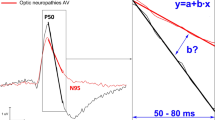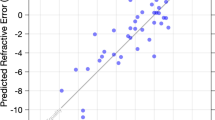Abstract
The influence of the axial length (AL) of the eye on flash electroretinogram (ERG) responses has been well established in the literature, suggesting an association between ERG abnormalities with myopia (AL > 25 mm). The aim of our present study was to determine whether the AL of normal eyes can also influence the pattern electroretinogram (PERG) on normal subjects. Thirty-nine normal volunteers were subjected to PERG measurements following the standard set by the International Society for Clinical Electrophysiology of Vision (ISCEV). The AL of the eyeball was measured using a TOMEY ultrasonic A scanner. Each volunteer had a complete ophthalmic examination including visual acuity, refraction, intraocular pressure, visual field, colour vision, orthoptic assessment and retinal photographs and had a best corrected visual acuity of 6/9 or better. Only one eye from each of the 39 normal volunteers was included in the statistical analysis of the results. The normal volunteer group had a mean P50 amplitude of 3.8 ± 1.1 SD μV. The range of AL was between 21.8 and 25.7 mm (mean = 23.8 ± 1.0 SD mm). Overall findings obtained from this investigation indicate a significant correlation between the AL of normal eyes and the PERG P50 amplitude (Spearman rank correlation coefficient r = −0.413, p < 0.01). The correlation accounts for 17% of the variance observed in the 39 amplitude values. This confirms the current hypothesis that the PERG amplitude is inversely related to axial length and means that AL should be considered when interpreting PERG amplitudes.
Similar content being viewed by others
References
Perlman I, Meyer E, Haim T, Zonis S. Retinal function in high refractive error assessed electroretinographically. Br J Ophthalmol 1984; 68(2): 79–84.
Pallin O. The influence of the axial size of the eye on the size of the recorded b-potential in the clinical single-flash electroretinogram. Acta Ophthalmol 1969; 191 (suppl): 1–57.
Westall CA, Dhaliwal HS, Panton CM, Sigesmund D, Levin AV, Nischal KK, et al. Values of electroretinogram responses according to axial length. Doc Ophthalmol 2001; 102: 115–30.
Bach M, Hawlina M, Holder GE, Marmor MF, Meigen T, Veagan, et al. Standard for pattern electroretinography. Doc Ophthalmol 2000; 101: 11–8.
Larsen JS. The sagital growth of the eye. IV. Ultrasonic measurement of the axial length of the eye from birth to puberty. Acta Ophthalmol 1971; 49: 873–86.
Anonymous. Standard for clinical electroretinography. International Standardization Committee. Arch Ophthalmol 1989; 107(6): 816–9.
Chen JF, Elsner AE, Burns SA, Hansen RM, Lou PL, Kwong KK, et al. The effect of eye shape on retinal responses. Clin Vision Sci 1992; 7(6): 520–30.
Kawabata H, Adachi-Usami E. Multifocal Electroretinogram in myopia. Invest Ophthalmol Vis Sci 1997; 38: 2844–51.
Author information
Authors and Affiliations
Rights and permissions
About this article
Cite this article
Hidajat, R., Mclay, J., Burley, C. et al. Influence of axial length of normal eyes on PERG. Doc Ophthalmol 107, 195–200 (2003). https://doi.org/10.1023/A:1026282425885
Issue Date:
DOI: https://doi.org/10.1023/A:1026282425885




